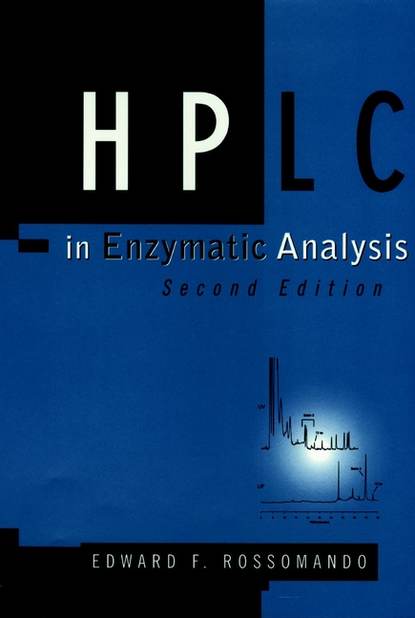Книга “High Performance Liquid Chromatography in Enzymatic Analysis”, авторы группы авторов, является продолжением первого издания, которое стало успешным.
С тех пор, как была опубликована первая версия этой книги, роль ферментов в биологическом исследовании расширилась, применение HPLC и ферментов распространилось на другие дисциплины, достижения в методах разделения и оборудовании увеличились возможности HPLC, а открытие новых ферментов породило новые методы анализа.
Второе издание книги “High Performance Liquid Chromatography in Enzymatic Analysis” охватывает эти разработки в своем обзоре усовершенствованных методов HPLC и их использовании в широком спектре лабораторных приложений. В нем предлагается тот же практический подход, который был найден в первом издании, включает множество новой информации в существующие главы и добавляет новые главы для решения новых задач, включая капиллярную электрофорез, криминалистическую химию, микродиализ и полимеразную цепную реакцию.
В книгу включены следующие темы:
- Применение HPLC для измерения активности ферментов;
- Концепции и теории;
- Новые методы и техники;
- Примеры из практики;
- Приложения в различных областях науки и промышленности.
Книга будет полезна для научных работников, студентов и всех, кто интересуется методами анализа ферментов и их применениями в биологии, медицине, промышленности и других областях.
The use of high-performance liquid chromatography (HPLC)-based analytical methodologies for enzyme kinetics has experienced enormous expansions since the original publication of this volume: new and previously undiscovered enzymes have been characterised and quantified with this technology; areas such as forensic, pharmaceutical, environmental, and food analysis have benefited greatly from the expedient analyses performed using HPLC with UV/Vis detection and other forms of post-column analysis; important new separation media for HPLC have received significant improvements; and most significantly, the technology itself has been metamorphosed in capability through improvements in chromatographic instrumentation, novel materials, advanced chemometric evaluative methods, electronic and automated data processing, fluid handling mechanisms, parallel and sequential miniaturised systems, and online systems.
In light of these changes, this unique volume incorporates refinements in HPLC methodologies alongside expanding the arena in which these methodologies function. In addition to an exclusive focus on the content of methods presented in the previous edition as well as incorporating a wealth of previously unreleased and newly gained information, new chapters have been added which not only address platforms covered by contemporaneous HPLC publications but also explore areas in which enzymes and HPLC usage have evolved and become hugely impactful. These tangents include topics such as capillary electrophoresis analysis, electrochemical detection, electrokinetic chromatography, chemical reaction monitoring in real time, ultraviolet reduction of enzyme damage, dynamic in-line chemical syntheses such as protodeclick reactions, pre-fractionation in support of complex sample preparation schemes, use of multiple reaction monitoring (MRM) and multi-dimensional chromatography on microscale chips, neural simulator design, use in membrane-based bioreactors for total analysis of fermentation conditions through the rapid analysis of extracellular metabolite mixtures, and in silico methods for enzyme assignment in affected patients.
Standard applications of HPLC methodology rotating around utilization in enzymatic activities continue to enhance analytical possibilities not once thought imaginable. Now, as in previous editions - and even clearer given strides the field has taken over the last decade - are the focused perspectives of analytists whose methodologies have been somewhat obscured in favor of generalised models built around powerful commercial methods. These authors contribute exemplary chapters that merge their irreducibly powerful perspectives upon resolving issues facing an entire community, whilst creating precision and utility with which analytical workflows may thrive. For anyone looking to master the art of HPLC enzyme analysis-from isolation to online automation-High-Performance Liquid Chromatography: An Introduction to Enzymatic Kinetics continues to offer the perfect nexus to success.
Электронная Книга «HPLC in Enzymatic Analysis» написана автором Группа авторов в году.
Минимальный возраст читателя: 0
Язык: Английский
ISBN: 9780470111000
Описание книги от Группа авторов
The use of High Performance Liquid Chromatography (HPLC) techniques in the study of enzymatic reactions has grown significantly since the publication of the first edition of this highly successful book: the role of enzymes in biological research has expanded; the application of HPLC and enzymes has extended to more disciplines; advances in separation techniques and instrumentation have increased the capability of HPLC; and the discovery of new enzymes has spawned new methods of analysis. High Performance Liquid Chromatography in Enzymatic Analysis, Second Edition addresses these developments in its coverage of the refinements of HPLC methods and their use in a wide range of laboratory applications. It offers the same practical approach found in the first edition, incorporates a wealth of new information into existing chapters, and adds new chapters to deal with new applications, including capillary electrophoresis, forensic chemistry, microdialysis, and the polymerase chain reaction. Topics include: * Application of HPLC to the assay of enzymatic activities * Concepts and principles of HPLC, including the latest technological advances * Concepts and principles of capillary electrophoresis (CE) * Strategy for design of an HPLC/CE system for assay of enzyme activity * Preparation of enzymatic activities from tissues and single cells * Analysis of enzymatic activities in body fluids, including chromatobiosis * HPLC for the identification of new enzymatic activities * Fundamentals of the polymerase chain reaction * HPLC in forensics * Survey of enzymatic activities assayed by the HPLC method, including many new categories * Multienzyme systems, including many new examples * HPLC in the analysis of contaminated food «It is the ability of HPLC to accomplish separations completely and rapidly that led to its original application to problems in the life sciences, particularly those related to purification. An analysis of the literature revealed that this technique was used primarily for the purification of small molecules, macromolecules such as peptides and proteins, and more recently, antibodies. This application to purification has all but dominated the use of the method, and there has been a plethora of books, symposia, and conferences on the use of HPLC for these purposes. However, it was only a matter of time before others began to look beyond and to explore the possibilities that result from the capacity to make separations quickly and efficiently.» –from the preface to the First Edition Easy to read and full of practical advice and hundreds of diagrams and examples, High Performance Liquid Chromatography in Enzymatic Analysis, Second Edition is an invaluable resource for students, researchers, and laboratory workers in analytical chemistry and biochemistry, molecular biology and cell biology, and for anyone interested in keeping up with this fast-growing field.



















